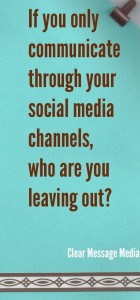By Carole Hayward
 I’ve been writing, developing, and producing e-newletters for more than ten years. They’ve evolved from glorified lists to powerful vehicles for driving traffic to websites to necessary components for converting your readers into customers.
I’ve been writing, developing, and producing e-newletters for more than ten years. They’ve evolved from glorified lists to powerful vehicles for driving traffic to websites to necessary components for converting your readers into customers.
Much has been said over the last couple of years that e-mail is over because social media will replace it. Despite the fact that many of today’s social media channels offer messaging for you to speak directly to your individual followers, e-mail communication is still thriving for a few key reasons:
- Not everyone uses social media. It’s great for those who use it, but not everyone does. That’s a fact. And even if people use it, it may well be that is not how they interact with your business. If you only communicate through your social media channels, who are you leaving out? Who didn’t get your message?
- E-newsletters drive people to your website. Websites, in and of themselves, are passive. They just sit there waiting for someone to find them. E-mail, on the other hand, is active. It blasts out and arrives in your readers/customers/members inboxes, and lets them know what you think is important. It guides them where you want them to go and positions you as an expert in a subject they are interested in.
- Customization and personalization are possible with e-newsletters in ways that social media just can’t measure up. Depending on the data that you have on your customers, you can develop content that is just for them. Let’s say you are a chiropractor, and you want to develop a newsletter for your customers. You have all of your patients’ e-mail addresses as part of their sign-up, so you don’t even need a campaign. You know who is there to receive care for their neck, back, and hips. You know the age and names of your patients. With just those pieces of information, for example, you could send a newsletter out that has unique blocks of copy for the elderly patient with a bad hip, the young girl with neck problems following a car accident, and the middle-aged patient with sciatica trouble, all for essentially the same costs as a single e-blast. Social media can’t reach out in those direct ways, at least not yet.
- It’s measurable in ways that social media isn’t. With a good e-mail service provider, you can not only tell how many people received it, opened the newsletter, and clicked on the links, you can also tell who clicked on what specifically. That is powerful data that can be studied to learn more about what those readers are interested in and would be willing to buy. Granted, that kind of data can cross the line into creepy or obnoxious, depending on how it’s applied (“Hi there, we see that you didn’t click on that last link in our newsletter last month, and we would like to know why.”)
- E-mail is still how business runs. People working in offices are engaged with e-mail all day. Younger generations may not engage in e-mail for their personal communications, but if they work for a business, they are using e-mail.
A caveat: Just as with any tool, using an e-newsletter incorrectly to overtly sell, bombard people with messages in ridiculous quantities, and apply your data in questionable ways will backfire, but that’s a subject for another post.
As a communications vehicle, an e-newsletter will allow you to reach more of your base, build their trust, and position you as an expert because you can share information that they want to read.


[…] hear back, especially on something that is time-sensitive. As Carole mentioned in a previous post, “Email is still how business runs.”To help increase your chance of writing an email that […]